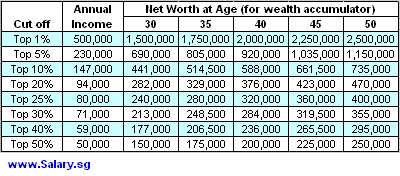Are you a university graduate who’s proud to be one of the top 20% of your cohort?
Or were you in the top 10% of the PSLE cohort offered to take Higher Mother Tongue Language*?
Or maybe you were invited to join the Gifted Education Programme, which means you’re in the top 1%?
Gasp.
But I hope the good feeling (and arrogance perhaps?) lasts into adulthood.
Now, go compare your current earning power with the income benchmarks below.
The numbers for annual income are based on the latest Iras report (see Compare Your Income), while the net worth values are calculated based on a rule of thumb (see Calculate Net Worth).
For example, if you are in your mid-thirties and make $94k per annum, you are at the bottom of the top 20%. This is arguably equivalent to a PSLE student just making it to a SAP school in 1995.
That’s not all. If your net worth is below $329k (use this tool to calculate), you are not a wealth accumulator.

* HMTL cutoff was subsequently relaxed to 20% in 1995 and 30% in 1999.




4 Comments
Pingback: Does Being An Elite Student Mean Elite Income?
Pingback: Are You Making Enough Money? (And Why “The Millionaire Next Door” Sucks) « The Curious Schemer
Thomas Stanley’s Millionaire Mind defines the expected individual net worth as follows:
Expected net worth = age x annual salary x 0.112
For example, if you are 30 years old earning an annual salary of S$30,000, according to the formula you should have an expected net worth of S$100.8K.
In his book, his respondents have a net worth of more than their expected Net Worth which actually demostrated that they are a group of wealth accumulators.
Somehow I think there should be a qualification to the above equation in terms of the time duration of maintaining the annual salary.
For example, a fresh NUS female graduate (say Jenny of 22 years old) is getting S$3000 per month. In the first year she gets 3000 x 13 (assuming 13th month with no other variable bonuses) = S$39,000.
Hence her expected networth is S$39,000 x 22 x 0.112 = S$96,096
How can anyone be “expected” to have a networth of at least 2 times more her annual income in the first year?
However if Jenny has now worked for 15 years (now 37 years old) and is commanding a salary of S$4500 per month, her expected net worth is S$4500 x 13 x 37 x 0.112 = S$242.4K
This is more palusible because if we assumed the total income she has brought in over the 15 years since she graduated her total income is S$3000 (using her graduate income instead of her last income for conservative sake) x 13 (number of months including 13th) x 15 years = S$585K
Hence her expected networth of S$242.4 is calculated to be 41% of the total income – in other words if she managed to save only 41% of her graduate income for the past 15 years, she would have hit her expected networth easily.
The key to the above example is to show that if one was to use the expected networth equation to work out his/her expected networth, we must be mindful that it’s best to have a number of years drawing/receiving that income for a sizeable period prior to using that equation.
Make Sense?
It’s called dwell time. *Eye-tracking (for large cursor movements) + game controller (for fine person movements, and clicking)* You can check out the eye-tracking subreddit (reddit/com/r/EyeTracking).
There’s a article of a redditor (has some RSI also) controlling
the desktop, and surfing Reddit with an eye tracker and a game
controller (youtube/com/watch?v=2IjTZcbXYQY). Eye gaze
is for instant large movements, the joystick is for fine movements, and
the controller buttons are for clicking. Before this set up,
I think the guy was actually using a foot pedal. Keep an eye on the
Eye Tribe, and Tobii forums also. See the interfaces that are already there, and keep track
of any new ones that come up. *Tag nearby elements w/ color & ID – project to large element (screenshot
and mock-up)* Since there can be difficulty in targeting the smaller elements of a non-touch/non-eye-tracking interface, there are
features such as magnification and snapping. I don’t know if those will be enough,
so I’m envisioning something that I don’t know if there’s any demand for this, but here’s a screenshot with a
mock-up that I made. It’s of an interface where larger, colored elements
project from smaller elements: i/imgur/com/3erfG6K.png